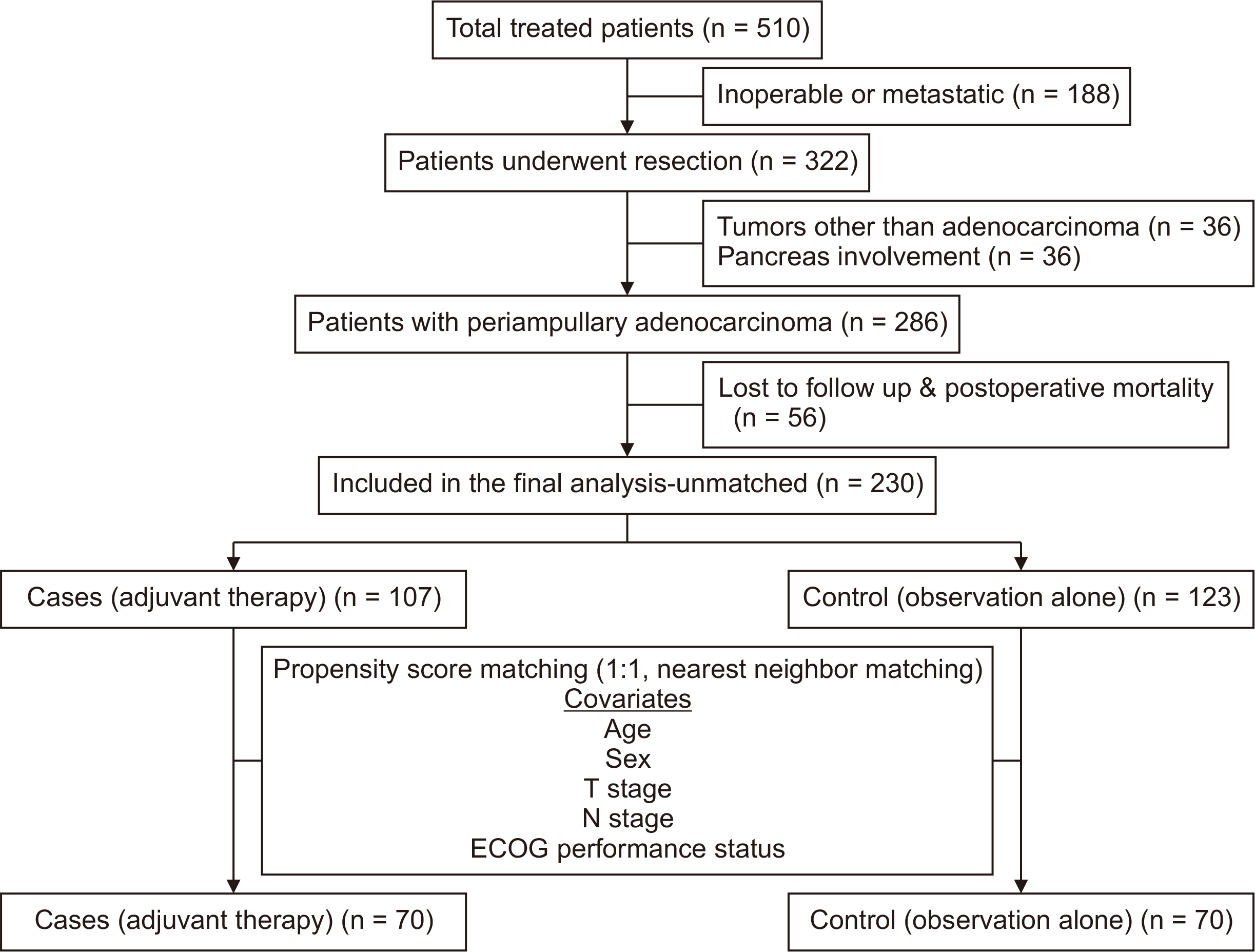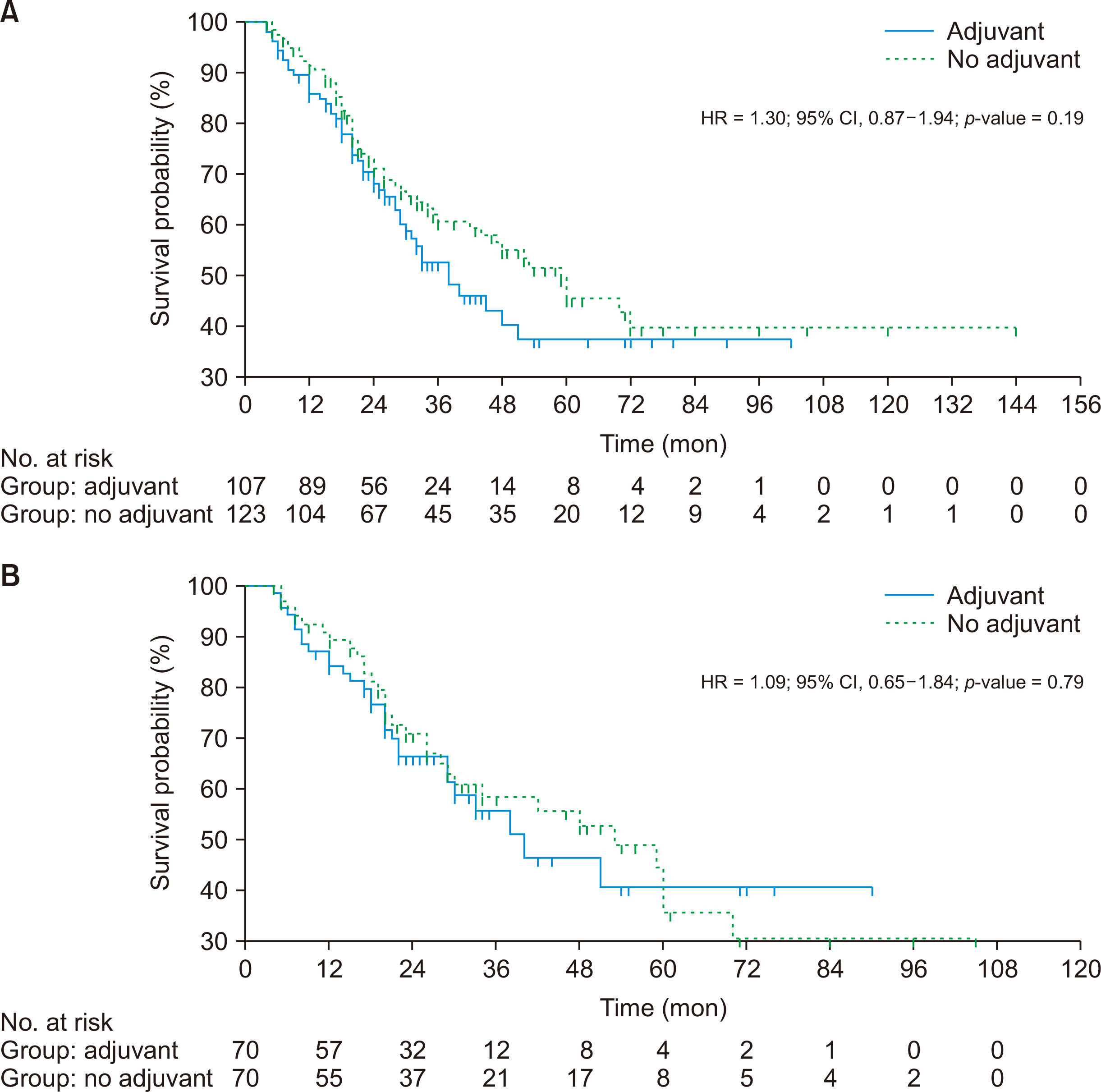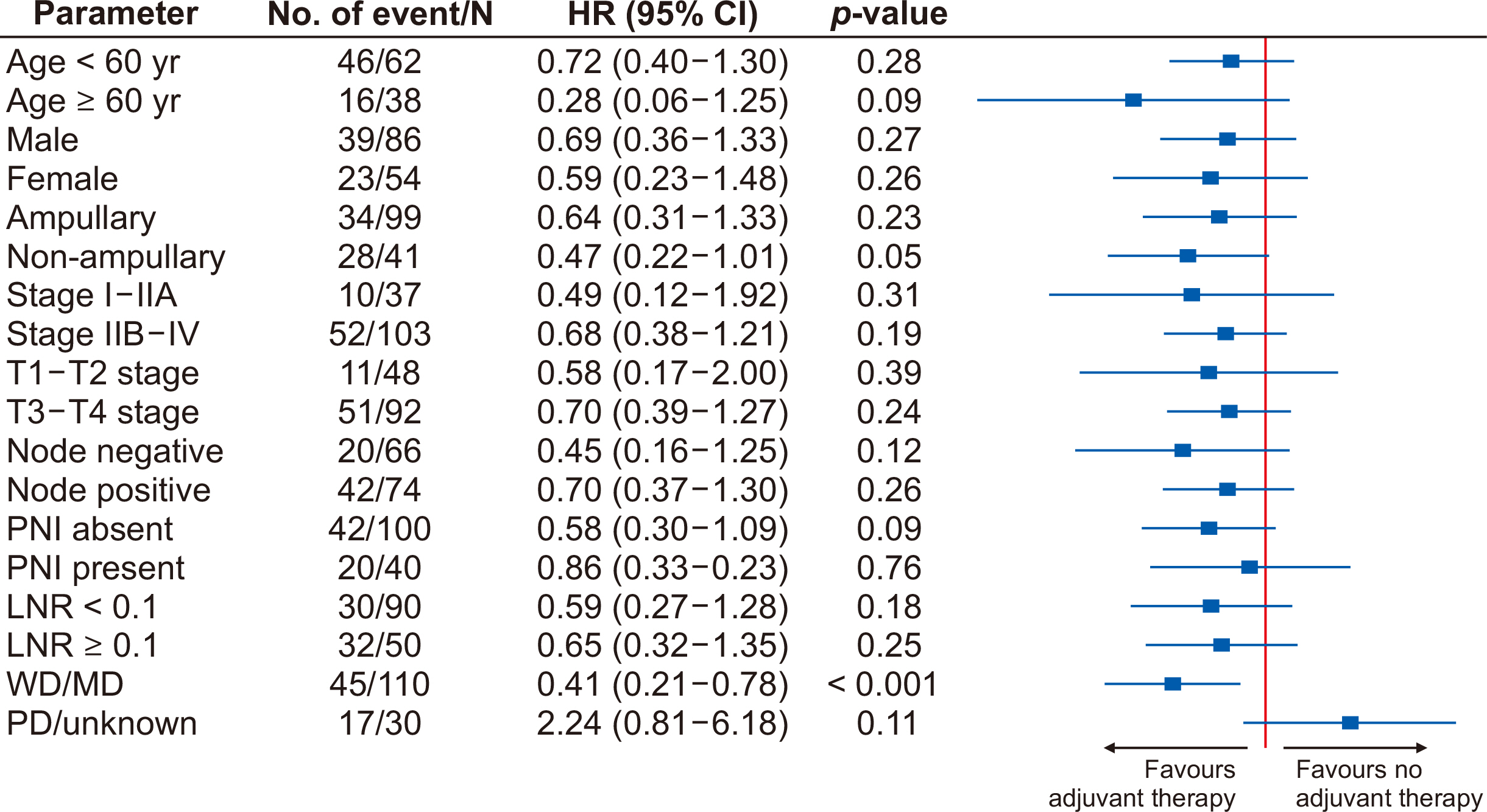Ann Hepatobiliary Pancreat Surg.
2024 Aug;28(3):371-380. 10.14701/ahbps.24-032.
Role of adjuvant therapy in resected periampullary adenocarcinoma: A propensity matched case-control study
- Affiliations
-
- 1Department of Radiotherapy, Maulana Azad Medical College (MAMC), New Delhi, India
- 2Department of GI Surgery, Govind Ballabh Pant Institute of Postgraduate Medical Education & Research (GIPMER), New Delhi, India
- 3Department of Gastro Medicine, Govind Ballabh Pant Institute of Postgraduate Medical Education & Research (GIPMER), New Delhi, India
- KMID: 2558652
- DOI: http://doi.org/10.14701/ahbps.24-032
Abstract
- Backgrounds/Aims
The published data had contradictory information on the role of adjuvant therapy on resected periampullary carcinomas (PACA). The study was performed to evaluate the survival benefit of adjuvant treatment.
Methods
This was a propensity score matched case-control study from a prospectively maintained database from 2004–2019. The study included patients with nonpancreatic PACA who underwent curative resection. The patients (cases) who received adjuvant chemotherapy were compared with patients (controls) who were observed alone after surgery.
Results
Of 510 patients with PACA, 230 patients (cases = 107, controls = 123) formed the unmatched study cohort. After propensity score matching, 140 patients (cases = 70, controls = 70) formed the matched study cohort. The median overall survival (OS) was similar in cases than controls in the unmatched population but doubled non-significantly in cases after matching (unmatched population, 54 months vs. 54 months, p -value = 0.624; matched population, 71 months vs. 36 months, p -value = 0.087). However, the median recurrence-free survival (RFS) was non significantly higher in the control group (unmatched population, 59 months vs. 38 months, p-value = 0.195; matched population, 53 months vs. 40 months, p-value = 0.797). In cox regression analysis, age < 60 years, advanced T stage, and presence of perineural invasion were independent factors for worse RFS, while tumor recurrence was an independent factor for poor OS.
Conclusions
Patients with nonpancreatic PACA may have an OS benefit from adjuvant chemotherapy, and this needs to be validated with large prospective randomized studies.
Keyword
Figure
Reference
-
References
1. Nakase A, Matsumoto Y, Uchida K, Honjo I. 1977; Surgical treatment of cancer of the pancreas and the periampullary region: cumulative results in 57 institutions in Japan. Ann Surg. 185:52–57. DOI: 10.1097/00000658-197701000-00008. PMID: 831636. PMCID: PMC1396263.2. Todoroki T, Koike N, Morishita Y, Kawamoto T, Ohkohchi N, Shoda J, et al. 2003; Patterns and predictors of failure after curative resections of carcinoma of the ampulla of Vater. Ann Surg Oncol. 10:1176–1183. DOI: 10.1245/ASO.2003.07.512. PMID: 14654474.3. Howe JR, Klimstra DS, Moccia RD, Conlon KC, Brennan MF. 1998; Factors predictive of survival in ampullary carcinoma. Ann Surg. 228:87–94. DOI: 10.1097/00000658-199807000-00013. PMID: 9671071. PMCID: PMC1191432.4. Choi SB, Kim WB, Song TJ, Suh SO, Kim YC, Choi SY. 2011; Surgical outcomes and prognostic factors for ampulla of Vater cancer. Scand J Surg. 100:92–98. DOI: 10.1177/145749691110000205. PMID: 21737384.5. Riall TS, Cameron JL, Lillemoe KD, Winter JM, Campbell KA, Hruban RH, et al. 2006; Resected periampullary adenocarcinoma: 5-year survivors and their 6- to 10-year follow-up. Surgery. 140:764–772. DOI: 10.1016/j.surg.2006.04.006. PMID: 17084719.6. Neoptolemos JP, Moore MJ, Cox TF, Valle JW, Palmer DH, McDonald AC, et al. 2012; Effect of adjuvant chemotherapy with fluorouracil plus folinic acid or gemcitabine vs observation on survival in patients with resected periampullary adenocarcinoma: the ESPAC-3 periampullary cancer randomized trial. JAMA. 308:147–156. DOI: 10.1001/jama.2012.7352. PMID: 22782416.7. Duan Z, Zhang Y, Tang Y, Gao R, Bao J, Liang B. 2022; Adjuvant therapy for periampullary carcinoma and the significance of histopathological typing: a systematic review. Transl Oncol. 20:101414. DOI: 10.1016/j.tranon.2022.101414. PMID: 35397420. PMCID: PMC9006738.8. de Jong EJM, Mommers I, Fariña Sarasqueta A, van der Geest LG, Heij L, de Hingh IHJT, et al. 2022; Adjuvant and first-line palliative chemotherapy regimens in patients diagnosed with periampullary cancer: a short report from a nationwide registry. Acta Oncol. 61:591–596. DOI: 10.1080/0284186X.2022.2053199. PMID: 35382678.9. Balachandran P, Sikora SS, Kapoor S, Krishnani N, Kumar A, Saxena R, et al. 2006; Long-term survival and recurrence patterns in ampullary cancer. Pancreas. 32:390–395. DOI: 10.1097/01.mpa.0000220864.80034.63. PMID: 16670621.10. Acharya A, Markar SR, Sodergren MH, Malietzis G, Darzi A, Athanasiou T, et al. 2017; Meta-analysis of adjuvant therapy following curative surgery for periampullary adenocarcinoma. Br J Surg. 104:814–822. DOI: 10.1002/bjs.10563. PMID: 28518410.11. Bhandare MS, Mondal A, Chaudhari V, Bal M, Yadav S, Ramaswamy A, et al. 2021; Factors influencing local and distant recurrence following resection of periampullary cancer. Br J Surg. 108:427–434. DOI: 10.1093/bjs/znaa143. PMID: 33723577.12. von Elm E, Altman DG, Egger M, Pocock SJ, Gøtzsche PC, Vandenbroucke JP. STROBE Initiative. 2008; The Strengthening the Reporting of Observational Studies in Epidemiology (STROBE) statement: guidelines for reporting observational studies. J Clin Epidemiol. 61:344–349. DOI: 10.1016/j.jclinepi.2007.11.008. PMID: 18313558.13. Ostwal V, Harris C, Sirohi B, Goel M, Bal M, Kannan S, et al. 2017; Role of adjuvant chemotherapy in T2N0M0 periampullary cancers. Asia Pac J Clin Oncol. 13:e298–e303. DOI: 10.1111/ajco.12612.14. Sunil BJ, Seshadri RA, Gouthaman S, Ranganathan R. 2017; Long-term outcomes and prognostic factors in periampullary carcinoma. J Gastrointest Cancer. 48:13–19. DOI: 10.1007/s12029-016-9863-z. PMID: 27484980.15. Park HM, Park SJ, Han SS, Hong SK, Hong EK, Kim SW. 2019; Very early recurrence following pancreaticoduodenectomy in patients with ampullary cancer. Medicine (Baltimore). 98:e17711. DOI: 10.1097/MD.0000000000017711. PMID: 31689805. PMCID: PMC6946574.16. Kim H, Kwon W, Kim JR, Byun Y, Jang JY, Kim SW. 2019; Recurrence patterns after pancreaticoduodenectomy for ampullary cancer. J Hepato-Biliary-Pancreat Sci. 26:179–186. DOI: 10.1002/jhbp.618. PMID: 30849209.17. Bhatia S, Miller RC, Haddock MG, Donohue JH, Krishnan S. 2006; Adjuvant therapy for ampullary carcinomas: the Mayo Clinic experience. Int J Radiat Oncol Biol Phys. 66:514–519. DOI: 10.1016/j.ijrobp.2006.04.018. PMID: 16863684.18. Ghosn M, Kourie HR, El Rassy E, Haddad FG, Hanna C, El Karak F, et al. 2016; Where does chemotherapy stands in the treatment of ampullary carcinoma? A review of literature. World J Gastrointest Oncol. 8:745–750. DOI: 10.4251/wjgo.v8.i10.745. PMID: 27795814. PMCID: PMC5064052.19. Klinkenbijl JH, Jeekel J, Sahmoud T, van Pel R, Couvreur ML, Veenhof CH, et al. 1999; Adjuvant Radiotherapy and 5-fluorouracil after curative resection of cancer of the pancreas and periampullary region: phase III trial of the EORTC gastrointestinal tract cancer cooperative group. Ann Surg. 230:776–782. DOI: 10.1097/00000658-199912000-00006. PMID: 10615932. PMCID: PMC1420941.20. Morak MJM, van der Gaast A, Incrocci L, van Dekken H, Hermans JJ, Jeekel J, et al. 2008; Adjuvant intra-arterial chemotherapy and radiotherapy versus surgery alone in resectable pancreatic and periampullary cancer: a prospective randomized controlled trial. Ann Surg. 248:1031–1041. DOI: 10.1097/SLA.0b013e318190c53e. PMID: 19092348.21. Smeenk HG, van Eijck CHJ, Hop WC, Erdmann J, Tran KC, Debois M, et al. 2007; Long-term survival and metastatic pattern of pancreatic and periampullary cancer after adjuvant chemoradiation or observation: long-term results of EORTC trial 40891. Ann Surg. 246:734–740. DOI: 10.1097/SLA.0b013e318156eef3. PMID: 17968163.22. Kamarajah SK, Bednar F, Cho CS, Nathan H. 2021; Survival benefit of adjuvant chemotherapy after pancreatoduodenectomy for ampullary adenocarcinoma: a propensity-Matched National Cancer Database (NCDB) analysis. J Gastrointest Surg. 25:1805–1814. DOI: 10.1007/s11605-020-04879-x. PMID: 33230687. PMCID: PMC8275534.23. Kim HS, Jang JY, Yoon YS, Park SJ, Kwon W, Kim SW, et al. 2020; Does adjuvant treatment improve prognosis after curative resection of ampulla of Vater carcinoma? A multicenter retrospective study. J Hepatobiliary Pancreat Sci. 27:721–730. DOI: 10.1002/jhbp.801. PMID: 32652820.24. Swaminathan R, Rama R, Shanta V. 2008; Lack of active follow-up of cancer patients in Chennai, India: implications for population-based survival estimates. Bull World Health Organ. 86:509–515. DOI: 10.2471/BLT.07.046979. PMID: 18670662. PMCID: PMC2647482.
- Full Text Links
- Actions
-
Cited
- CITED
-
- Close
- Share
- Similar articles
-
- Adjuvant Chemotherapy Versus Chemoradiation for Patients with Resected Pancreatic Adenocarcinoma: A Single-Center Retrospective Study
- Is There a Role for Adjuvant Therapy in R0 Resected Gallbladder Cancer?: A Propensity Score-Matched Analysis
- Propensity score analysis of adjuvant therapy in radically resected gallbladder cancers: A real world experience from a regional cancer center
- Prognosis for Periampullary Cancers after Pancreaticoduodenectomy
- Impact of Postoperative Oral Administration of UFT for Completely Resected pT2N0 Non-Small Cell Lung Cancer





